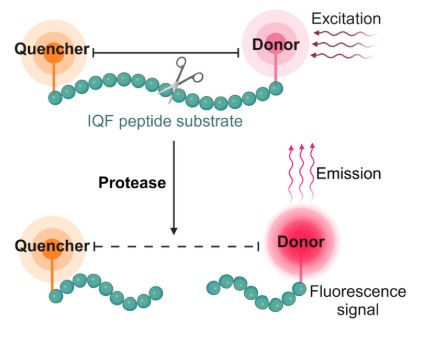@jeyunjo.bsky.social @christianslentz.bsky.social @jalal228.bsky.social @sijiewang.bsky.social
30.05.2025 23:29 — 👍 1 🔁 1 💬 1 📌 0
I'm thrilled to share that my second paper from my postdoctoral work is now published! A heartfelt thank you to my PI, Prof. Bogyo @mbogyo.bsky.social, for his unwavering support throughout this project. I am also deeply grateful to our fantastic collaboration team for making it a great success.🙌
30.05.2025 23:26 — 👍 7 🔁 1 💬 1 📌 0

a figure from a scientific paper depicting the fluorescent reporter assay for chikungunya virus protease activity. in places where the protease is inactive, there will be no fluorescent signal due to the physical proximity of the quencher and the donor (linked by a peptide substrate). where the protease is active, the peptide substrate will be cleaved and will free the donor from the influence of the quencher and thus produce a fluorescent signal upon excitation.
🧪 Working to develop #drugs to treat #chikungunya ? Check out new fluorogenic substrates that help read out viral protease activity, developed by @tulsiupadhyay.bsky.social @westberglab.com @eunayoo.bsky.social @michaelzlin.bsky.social et al! pubmed.ncbi.nlm.nih.gov/39981948/
03.03.2025 20:57 — 👍 5 🔁 2 💬 0 📌 0
Another big publication from @sijiewang.bsky.social this week. Check out our efforts to use mRNA display to screen for covalent binding inhibitors of Staphylococcus aureus serine hydrolases. pubs.acs.org/articlesonre...
27.02.2025 16:54 — 👍 19 🔁 4 💬 3 📌 0
Excited to repost the news on this new platform!! Great collaborative work under the mentorship of @mbogyo.bsky.social is out for your read.
10.01.2025 19:53 — 👍 3 🔁 1 💬 0 📌 0






